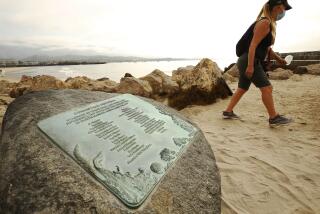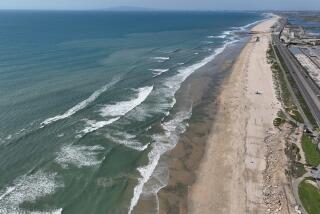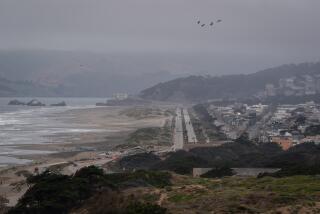Money Troubles Rocking Coast Guard’s Boat : Protector of Shoreline Is Staying Afloat Despite a $35-Million Deficit, Cuts
GOVERNOR'S ISLAND, N.Y. — While our century-old Lady of the Harbor looks on, the no-nonsense boats and aircraft emblazoned with the familiar vermilion insignia will shepherd about 40,000 boats and warships this Fourth of July.
It won’t look as if the U.S. Coast Guard is broke.
But it nearly is.
Efforts are under way in Congress to rescue the service for the next fiscal year starting Sept. 30, but that won’t restore the deficit for this year.
$35 Million Short
The 196-year-old service that guards the shorelines is running $35 million short, having cut more than $100 million in operating expenses so far this year, mostly by deferring maintenance, reducing training and virtually halting routine patrols. The Coast Guard doesn’t go to sea these days unless there is clearly trouble out there.
While coping with an operating budget pared to $1.69 billion in 1986, the Coast Guard has trimmed its manpower by almost 2,000 people through attrition in the last five years.
And impending are more cuts if Gramm-Rudman reductions are imposed indiscriminately.
Adm. James S. Gracey, who retired as commandant on May 30, says his tactic, should budget cuts become too stringent, would be to continue to perform Coast Guard functions, only in fewer places.
Chasing Down Smugglers
Over and over in any calendar year, the Coast Guard is called on to do yeoman’s work: the routine chores of maintaining buoys on the Mississippi River or navigation stations around the world, chasing down smugglers and illegal immigrants, dogging icebergs, yanking stricken sailors from the sea, checking fishermen for illegal catches.
There is always special duty when hurricanes strike. The Coast Guard even directs ships worldwide to the aid of other ships in trouble. Its computers watch over a quarter of the world’s maritime fleet.
Last year, a Coast Guard helicopter flying at night saw a suspicious boat in Miami’s Biscayne Bay, called in two 41-foot patrol boats that corralled the boat and chased the three-man crew into the arms of waiting Miami police. The result: the biggest cocaine bust in Coast Guard history, almost a ton.
This Year’s Prime Crisis
This year’s prime crisis was the long search after the space shuttle Challenger went down. Now comes the Fourth of July and the 100th birthday of the Statue of Liberty, which are expected to draw twice as many seagoing visitors to New York harbor as sailed in for the Bicentennial.
And the statue’s birthday is being staged in a world that sees terrorists everywhere.
All of this when the thin blue line has been stretched even thinner, and the ships and planes that wear Coast Guard red are spending more time at home.
“We’re coming up on the busy season,” Gracey said. “We’ve been doing without maintenance. We’re eating into spare parts boxes.”
Mission Depended on Mail
He said he visited one unit recently where a patrol boat’s going on a mission “depended on whether the morning mail brought the part it needed. You can only do that so long, and then you just have to shut them down.”
“We’re trying to avoid tying up ships and aircraft and taking crews off them, getting rid of people,” the admiral added. “Especially with the President saying, ‘I want the Guard up there. I want them to do their thing.’ ”
Nevertheless, routine patrols have been cut to the nub, fishery patrols cut in half, spare parts purchasing stopped. Some units work 80 to 100 hours a week. A more normal workweek would run 70 hours. The Coast Guard’s men and women spend up to six months of the year at sea, especially the polar icebreakers, and Gracey is unwilling to ask more. At one point this spring, seven search-and-rescue stations in southern Florida were on “Crew Fatigue Status,” which means new priorities are set and operations are pared because fatigue could affect safety.
Another Money-Short Unit
The service depends on the Department of Transportation’s ability to give it operating funds for the rest of the fiscal year. The transportation department has another money-short unit as well--the Federal Aviation Agency, in charge of air and airport safety.
Hanging over all federal agencies is the possibility of across-the-board cuts under the Gramm-Rudman Act.
“It’s possible to live with Gramm-Rudman if it is, as I believe it was meant to be, administered on a priority basis,” the admiral said. “It’s a case of getting Congress to decide what the priorities are . . . .”
The Coast Guard’s pinch started in Congress. Last fall the Senate came up with $230 million in cuts. That would have meant laying up a third of the ships and planes and laying off 20% of the 39,000 Coast Guard force.
Cut Was Reduced
A Senate-House conference committee reduced the cut to $36 million, but about the same time Congress passed a military pay and benefit bill that cost the Coast Guard another $30 million. Congress didn’t provide the money and the Coast Guard was left $66 million in the hole.
Then came Gramm-Rudman cuts for fiscal 1986 of $76 million, leaving the service a shortfall of $142 million. The Coast Guard went into a squeeze-down, hold-down, buy-nothing policy, but still is looking at the $35 million that isn’t.
The Coast Guard insists that its budget is as lean as possible, especially compared to megabuck Washington services and agencies.
Gracey said he got angry enough to write a letter when a Washington paper recently quoted an unidentified official who said that any agency that hasn’t padded its budget enough to absorb a 5% cut wasn’t doing its job.
Using Own Money for Parts
“I heard about one of our units who were buying some spare parts with their own money,” the admiral said.
Meantime, the Coast Guard is gearing up for Miss Liberty’s birthday in New York Harbor. It is calling in 70 boats and ships from Eastern Seaboard stations, bringing up reservists and Coast Guard auxiliary with their own boats.
Capt. Arthur Henn and his deputy, Cmdr. Eric Williams, said that all agencies included--the Coast Guard, the FBI, Naval Intelligence, Customs, Immigration and the New York Police Department--will field a security force of 100,000. But by planning and concentrating effort during the three-day celebration, the force should wield the clout of 500,000.
Tall Ships Will Be There
Nearly 50 U.S. and foreign naval vessels will be on station and on parade, as well as the tall ships that were present at the Bicentennial. Traffic will be horrendous--stalled boats, people falling into the water, medical problems. And the possibility of terrorism hangs over the harbor as well. Other law enforcement people will ride with the Coast Guard, providing extra eyes to focus on suspicious events.
Cost is almost impossible to estimate. Officials say the service may spend as much as $1 million for its brief effort. Again not funded.
But the Coast Guard is used to stretching and making do. When it reached out to take in the 200-mile limit nine years ago, it realized that it would be encountering language problems when it faced foreign ships. It sent one guardsman to school to learn Russian.
The Challenger search this year cost about $2 million.
Three Boats on Patrol
The Coast Guard had three boats on patrol for the space shot, the 82-foot patrol boat Point Roberts and two high-speed, multipurpose 41-footers. Their normal assignment: to ward off interlopers and participate in rescue efforts if necessary.
It turned out to be necessary. The range safety officer ordered all ships and aircraft out of the area for about 40 minutes to avoid falling debris. Then the Point Roberts, under the command of a lieutenant, and its tiny fleet swept into action, aided by Coast Guard helicopters and planes. The 210-foot cutter Dauntless arrived at 8 p.m.
Normally, it would have taken longer for the Dauntless to reach the site, but the cutter had been diverted from drug patrol off the Bahamas, south of Miami, to rescue a small Haitian sailboat with 72 aboard well north of its station.
Haitian Vessel Foundering
A merchantman had radioed that the Haitian vessel was foundering. Seas driven by 20-knot winds and 60-knot gusts were rising to 20 feet. A Coast Guard helicopter was first on the scene, lowering its rescue basket, which a dozen desperate hands grasped at once. It was too much for the winch, so the helicopter simply rose above the seas with its human cargo dangling below, and airlifted them to the freighter.
The Dauntless arrived and saved the rest by lowering small boats.
That completed, the Dauntless was ordered to the Challenger crash scene. It was reinforced by the 378-foot cutter Dallas, also pulled off drug patrol.
Coast Guard units have had to skimp less in Florida, where they face a flow of illegal immigrants from Haiti and the ever-busy drug runners.
7,000 Haitians Caught
About 7,000 Haitians have been caught since the interdiction began in October, 1981. The Coast Guard has intercepted about 1,100 Haitians since the fall of the Duvalier government.
They continue to come in leaky, rotting sailboats, jammed to the gunwales. One 44-footer had 164 aboard. Usually the boats are in such bad shape they are simply destroyed at sea, and the Haitians returned to their island.
One boat capsized after most of its passengers were pulled to safety. About a dozen people drowned, including an Immigration and Naturalization Service interpreter.
One Coast Guard cutter is always stationed north of Haiti on interdiction patrol. Other cutters are pressed into action to pursue those who slip by.
7,500 Pounds of Cocaine
In addition, the Caribbean patrols seize about 2 million pounds of marijuana a year. Last year the Coast Guard also intercepted 7,500 pounds of cocaine, up from 2,000 pounds the year before.
Some catches are enormous. Ninety tons were intercepted on a barge last fall by the 327-foot cutter Taney. The Taney is the only ship still active after surviving the bombing at Pearl Harbor in 1941.
In all, patrols seize 230 drug boats a year, so many that they jam waterways from the Keys to the Miami River. Every so often to relieve crowding, the boats are auctioned off with other captured airplanes and cars. The auction last April brought more than $3 million. The money does not go into Coast Guard coffers.
Fleet Up to Date
Operations cuts aside, the Coast Guard’s fleet of aircraft and boats has been brought up to date. And it has been relieved of having to answer every boating problem. The policy now is to call commercial towing services for boats in trouble, unless life and property are in danger.
More to Read
Sign up for Essential California
The most important California stories and recommendations in your inbox every morning.
You may occasionally receive promotional content from the Los Angeles Times.










